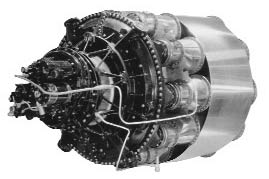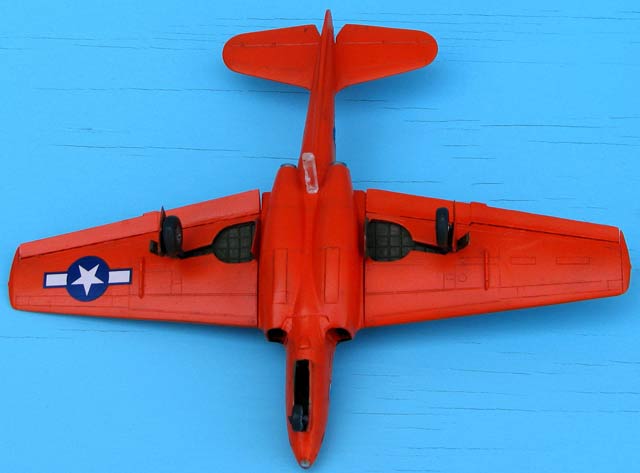Bell P-59 Airacomet First American Jet Fighter

Aircraft design took a major step forward with the introduction of the jet engine. Although unknown to the Allies, the first pure turbojet-powered aircraft had already flown one month before World War II began in Europe, in the form of the Heinkel He 178. By mid 1942, the Messerschmitt Me 262 was making itself known, and the British designed Gloster E28 had flown earlier in the same year.
As far back as September 4, 1941, the Army Air Force began a discussion that eventually led to the first American jet powered aircraft, the Bell P-59 Airacomet. Though design of the airframe was American, the powerplant design was obtained from the British Whittle engine used in the Gloster jet This engine was put into production by General Electric as their Model I-A, two of them being installed in the new Bell fighter.
Bell P-59 Airacomet

 The desire to keep the existence of the jet propulsion program absolutely secret led to the adoption of the designation already assigned to the defunct XP-59 pusher. On paper, it would appear that the jet was actually a continuing development of the propeller aircraft, thus camouflaging its true configuration. In fact, to keep this impression, the first XP-59A jet was fitted with a dummy wooden propeller whenever it was moved about on the ground, and the cavernous engine intakes were faired with canvas for concealment.
The desire to keep the existence of the jet propulsion program absolutely secret led to the adoption of the designation already assigned to the defunct XP-59 pusher. On paper, it would appear that the jet was actually a continuing development of the propeller aircraft, thus camouflaging its true configuration. In fact, to keep this impression, the first XP-59A jet was fitted with a dummy wooden propeller whenever it was moved about on the ground, and the cavernous engine intakes were faired with canvas for concealment.
A contract for three XP-59A jet fighters was signed on October 3, 1941, and the first machine was completed at the Bell plant in Buffalo, New York, eleven months later. The fighter was dismantled and shipped to Muroc in the California desert for flight tests. The initial flight was made on October 2, 1942. The General Electric engines each developed 1,400 Pounds of static thrust to push the fighter to a speed of 404 mph at 25,000 feet. The performance of the first American jet was not spectacular, but one of thirteen YP-59As did establish a new unofficial altitude record of 47,600 feet. Following the order and delivery of the thirteenYP-59A Airacomets with 1,650 lb. thrust engines, the Army received 20 P-59As and 30 P-59B's, all powered by J31-GE5 engines of 2,000 lbs. s. t.
Flight evaluation uncovered a tendency for the P-59 to yaw, or sway, from side to length was 38 feet 10 inches, and height was side making it unsuitable as a fighter. Instead, the planes were relegated to the training of jet pilots to prepare them for new generation of fighters coming off the drawing boards. A proposal for a single-engine model of the Airacomet was labeled XP-59B with the engine being fed via intakes in the roots of the low mounted wing and exhausting beneath the fuselage. Bell Company was unable to devote the necessary time on the single-engine design however, and this plan was passed on to Lockheed, eventually appearing as the Shooting Star.
Curiously, the XP-59A made a very satisfactory glider, the test pilots often flying until the fuel ran out then gliding back to Muroc for a landing! Empty weight of the P-59B was 8,165 pounds. Armament installed in the P-59 included three .50 cal. machine guns with 600 rounds and one 37 mm cannon with 45 rounds,
The P-59B had a maximum speed of 413mph at 30,000 feet. Cruising speed was 375 and service ceiling was 46,200 feet
 |
The first US jet aircraft, the Bell P-59 Airacomet, made its maiden flight on October 1,1942, powered by two 1,300-lb thrust General |
 It was agreed that Bell would design
and build three airplanes, and General
Electric would supply 15 versions of the
British engine design. Every precaution
was to be taken against leakage of the
project's details, and it was initially assigned an unusual "Special Secret" security classification.
It was agreed that Bell would design
and build three airplanes, and General
Electric would supply 15 versions of the
British engine design. Every precaution
was to be taken against leakage of the
project's details, and it was initially assigned an unusual "Special Secret" security classification.
A $1.6 million contract with Bell, signed on September 30, 1941, called for the first aircraft to be delivered eight months later. The plane was designated the XP-59A-so it would appear to be a continuation of Bell's prop-driven XP-59 design, which would be cancelled in December 1941. Bell assembled a team to design and build the prototypes and impressed upon it the need for absolute secrecy. The engineers were moved to a former Pierce-Arrow automobile factory in downtown Buffalo. Later on, production was moved to the second floor of a three-story building, where a machine shop took the place of a Ford car agency. The building's windows were welded shut and the glass painted over. Guards were placed around the building on 24-hour watch.
The Bell engineers were given free rein in the aircraft's design with the provision that it had to accommodate the twin jet engines that GE's engineers would eventually provide. Meanwhile, Whittle's W.1X engine was delivered to the GE plant in West Lynn, and a special engine test cell was constructed. The first test run was made on November 7, 1947, but GE's engineers found some omissions and discrepancies in the drawings that accompanied the engine and made changes that resulted in the first GE model, designated the I-A.Its first test run was made in March 1942. Whittle arrived from England in June 1942 to help solve excessive gas temperature problems.

It had been decided from the beginning that the XP-59A would eventually be a production fighter, not just an experimental plane with no combat mission. The original armament specification called for two 37mm cannons in the nose compartment. A 1/16-scale model was tested secretly in a wind tunnel at Wright Field, Ohio, as the plane's shape was defined.
Work on the first plane began on January 9, 1942. Fabrication of its component parts had to be farmed out to Bell's main factory where the drawings were disguised with false labels. A month later, Bell was asked to submit an estimate to produce 13 YP-59As for service tests, plus a plane for static tests, wind tunnel models and spare parts. Those aircraft were to be essentially the same as the three X models, except that they would have a sliding canopy instead of a hinged canopy that was raised over the pilot's head.
While the first planes were being manufactured, a search was underway for a secure location for test flights, which could not be carried out near Buffalo. The location chosen was the Army Air Forces bombing and gunnery range on Rogers Dry Lake in the Mojave Desert area of California. The dry lake bed covered about 65 square miles with no obstructions, making it ideal for testing aircraft that might need much takeoff and landing space. The XP-59As airframe was too conventional for its new engine, making it unable to compete in dogfights with propeller-driven fighters such as the Republic P-47D or Lockheed P-38J.
The first jet engine arrived in Buffalo on August 4, 1942,and the first XP-59A was ready for shipment on September 10. To provide access for the plane, workmen had to knock a large hole in the side of the brick building, after which three large crates were lowered onto two railroad flat cars. To assure that the high precision bearings in the engines would not be damaged by the pounding of the rails, a small door was cut into the side of the fuselage crate and an air compressor was hooked up with a flexible pipe to pump air to the engines and keep the turbine blades rotating. An officer and five enlisted men plus three GE mechanics were assigned to the equipment to be sure the turbines would be turning continually for the entire trip. One veteran trainman, puzzled about the compressor blasting away day and night, said to one of the GE men, "Hey, send me a telegram collect when the war's over and tell me what's in those crates."
Larry Bell, meanwhile, chose chief test pilot Robert M. Stanley to establish and run the initial flight test program. Stanley's experience with aircraft dated back to 1931, when he worked for the Douglas Aircraft Company, then graduated from the California Institute of Technology with a degree in aero- nautical engineering and joined the Navy for a four year tour as a pilot. He started working for Bell in 1940. Stanley familiarized himself with the aircraft and the operation of the jet engine before departing for California. He was not pleased when he arrived to find that little had been done to accommodate the men who would be conducting the tests and meet the October 2, 1942,date that had been designated for the first official flight. He quickly made arrangements with a contractor to construct a new base on the north side of Rogers Lake, away from prying eyes. There was some resistance from the base commander, who didn't concur with the urgency of his demands, but Stanley was determined to have barracks and a hangar erected by the time the first plane arrived. When the date neared, he ordered the civilian workers out, and the work on the facility was completed by a dozen Bell employees from Buffalo.

 Designer, Aarron Murphy often uses the design program 'Rhino' to figure out the bits and pieces of a design. These are two of the views he's created for this Bell Airacomet P-59 project. According to Aaron, the program is good, however somewhat pricey. |
 |
 |
  |
 |
 |
 |
 |
 |
| Cockpit of the Bell P-59 Airacomet. |
Specifications for the Bell P-59 Airacomet
 |
Length: 38 ft 2 in Wingspan: 45 ft 6 in Height: 12 ft 4 in Wing area: 386 sq ft Empty weight: 7,940 lb Max takeoff weight: 12,700 lb Powerplant: 2× General Electric I-A turbojets, 2,000 lbf each Performance Maximum speed: 413 mph Range: 240 mi Service ceiling: 46,200 ft Rate of climb: 3,200 ft/min Armament 1x 37 mm cannon 3x .50 cal (12.7 mm) machine guns |


 Electric 1-As. Although it was originally intended to be a fighter, its combat performance proved inferior to that of piston-engined contemporaries and it served mainly as a trainer.
Electric 1-As. Although it was originally intended to be a fighter, its combat performance proved inferior to that of piston-engined contemporaries and it served mainly as a trainer.